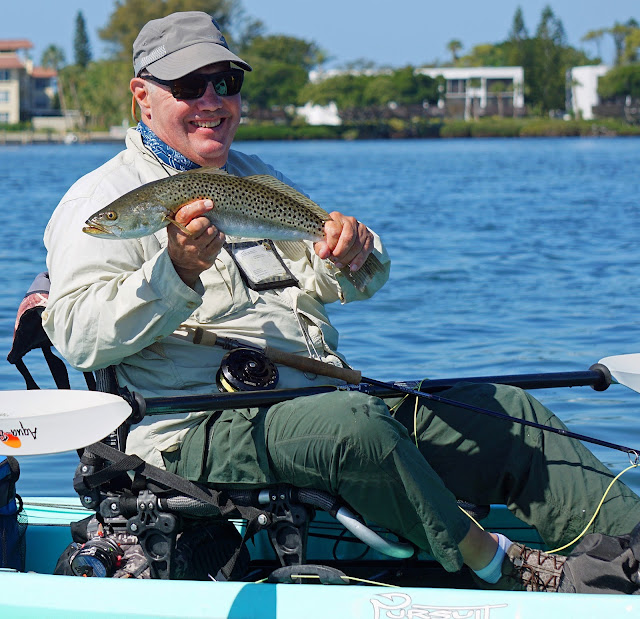 |
| Three oblivious charterboat anglers pose beside their bounty of dead fish lined up on the cleaning table at the dock. |
Perhaps that's why there are many things in life I don't
understand.
Like meanness. Cruelty. Insincerity. Rudeness.
 |
| This fine redfish was photographed quickly, then released. |
I don't understand why some people who enjoy the great
outdoors don't respect it. They throw trash out of the windows of their vehicles.
Cut across shallow, fragile grass flats in their boat, gashing out ugly prop
scars with their outboards.
Daily, I see people driving down the road smoking cigarettes
and flipping them out the window when they're done.
There's a common thread here: selfishness. They want to so
therefore they do.
What's the big deal?
One of my pet peeves is photos of dead fish. I don't mean
photos of fish killed by pollution, red tide or some other natural disaster.
I mean fish that have been caught by humans, deposited in an
ice chest and then later hung up, lined up or held in front of a camera.
 |
| Actions photos are better options than dead fish. |
In most cases, the fish corpses are colorless and stiff.
What I see when I view photos of these dead fish is people
saying, "Hey, look at me. Look at what a big man I am. Look how many fish
I killed."
It's all ego-driven.
While littering, destruction of natural resources and other
acts are illegal, taking photos of dead fish is perfectly legal.
But here's the rub: Sometimes what legal isn't necessarily
right. It could fall under the auspices of outdoor ethics. If you make your
living off the great outdoors, then you have an ethical responsibility to
respect it and protect it.
If you want to see what I'm talking about, you'll see it on
most any social media if you have any outdoors friends. I see it all the time
on Facebook, Twitter and Instagram.
I was a professional outdoors writer for 35 years. And over
the last 25 years of my career, I did not use a photo of dead fish. That
practice was quite common in outdoors publications around the country in prior
to 1985. But it slowly changed over the years. And you'll rarely see a
dead-fish photo in any reputable outdoors publication these days.
I like to think I was ahead of the game.
Just recently, I saw a photo on the Facebook page of a local
charterboat guide. His party of three smiling anglers posed beside 14 dead
spotted seatrout and two Spanish mackerel lined up stiff and colorless on a
cleaning table at the dock.
I also saw two local charter guides in a photo on television
each holding dead snook. The fish were long dead, stiff and had their throats
slashed.
I am offended by these pictures. They make me sick. They
show no respect whatsoever for the fish, fisheries or great outdoors.
Why in hell are people still focusing on catching and
killing limits of fish? Some might argue that I am against people catching fish
and taking them home to eat.
Not so.
I am against the philosophy that you have to kill all or the
majority of legal fish you catch.
It doesn't make much sense. It especially doesn't make
economical sense. You pay $700 for an all-day charter to take home five pounds
of filets. Care to figure out how much that 80 ounces fish flesh costs you?
If eating fish is the main goal, save the charter money and
take your significant other out to a fine seafood restaurant.
You'll come out way ahead.
With that in mind, I don't mind if an angler wants to take a
fish or two home. No big deal. But rather than posing with a fish corpse back
at the dock, take a photo of the fish right after the catch while it's alive
and vibrant.
I was watching an outdoors show on television recently where
the host and guest were fishing for redfish in shallow water. They did pretty
well, too.
They released most of the fish, but kept a 25-incher.
"That one's going in the skillet," the host
grinned as he lifted the lid to the color and dropped the red in.
That didn't have to be in the video. It could have been
edited out and no one would have be the wiser.
One practice that really annoys me is gaffing. I watch
fishing shows on TV and they'll stick a gaff in a large fish, then haul it
aboard. We as viewers have to watch as the fish struggles and bleeds.
I don't watch many fishing shows any more (especially those
who seem to delight in killing fish), but sometimes you can't avoid it.
I'm just amazed at the number of dead-fish photos I see
today. They're on Facebook, Twitter, Instagram and other media.
They annoy the crap out of me. I hope you feel the same way?
There are many things that were common practice 40 or 50
years ago that aren't cool today.
Some day photos of dead fish will be a thing of the past.
I certainly hope so.
Some day photos of dead fish will be a thing of the past.
I certainly hope so.



































